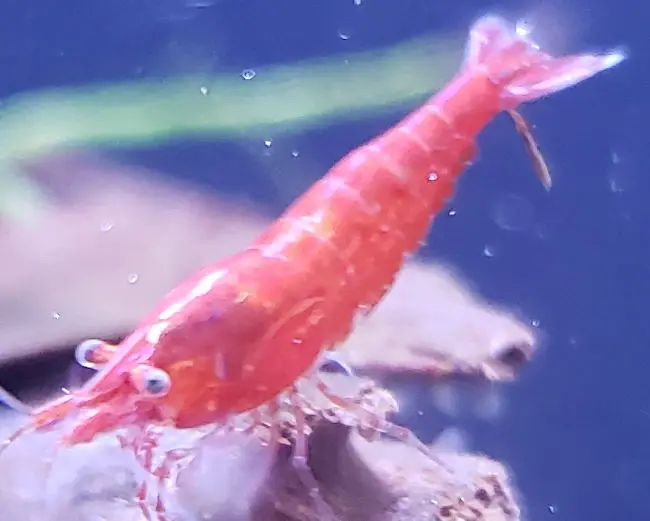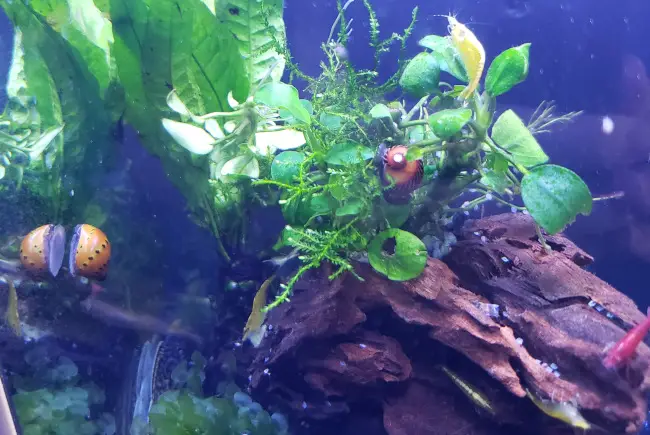
| Scientific Name | Neocaridina denticulata sinensis |
| Difficulty | Easy |
| Minimum Tank Size | 10 Gallons |
| Water Parameters | 60-80° F, KH 3-10, pH 6.6-7.0 |
| Diet | Peaceful |
| Aggression | Semi-Aggressive |
| Size | 1.5" |
The Red Cherry Shrimp is one of the more popular freshwater shrimp available. They feature a stunning red coloration, are fairly hardy and remain affordable. They are a fair bit smaller than many other commonly kept shrimp and will be put in danger if kept with any predatory fish. They are very easy to breed but only live for two years. If you want to keep them long term avoid fish that will hunt their young.
Cherry shrimp are held in different grades depending on their coloration. The stronger their color the higher grade they are. This can make their price vary in local fish stores and also make it easier to buy higher grade Red Cherry Shrimp online.
The four grades, listed in order from lowest to highest would be: Cherry Shrimp, Sakura Cherry Shrimp, Fire Red Shrimp and Painted Fire Red Shrimp. Only the highest grade shrimp will have red legs. It is much easier to determine the grading of shrimp using males, as the females will have a much stronger coloration regardless of their grading. If you are looking for high grade cherry shrimp look for males only, which will not have a yellow/orange saddle on their stomach.
These shrimp will spend a large amount of their time walking on the lower half of the tank, searching for food among the substrate as well as in any plants or rock formations. This page will be focused on caring for the Red Cherry Shrimp, preventing sickness, a healthy diet, tankmates and the way their tank should be set up.
Red Cherry Shrimp Habitat
The Red Cherry Shrimp makes its home in the highly planted waters of Taiwan. They live in streams and small bodies of water. These places grow large amounts of algae which is the Red Cherry Shrimp main food source in the wild. They are not used to strong currents and will try to stick to low flow areas.
Knowing these things we should focus on replicating their original homes in the aquarium. To start the equipment we use should be safe for small shrimp.
Two of the biggest dangers we can introduce to the tank are copper infused water and strong filtration systems. Most bodies of water that contain inverts will have little to no copper in them. Testing the aquariums water with a copper testing kit will keep us from accidentally poisoning our shrimp the moment we add them to the tank. If the test strip shows white or nearly white then the tank should be safe for the Red Cherry Shrimp. Once the strip starts to look anywhere near peach colored the water would need to have its copper levels reduced. This is especially important for homes with copper pipes in their water systems.
Likewise the Red Cherry Shrimp is sensitive to high nitrite levels. These are the product of bacteria breaking down ammonia, which is created by waste in the aquarium. Nitrites are broken down further by a second type of bacteria into nitrates, which are far less toxic and absorbed by the plants we keep with our shrimp. In short the Red Cherry Shrimp should not be placed in a new, uncycled tank. They should only be kept in tanks that have an established colony of bacteria. These can be quickly built up in new tanks by using old filtration media from a nearby tank or even some substrate. Most areas will have aquarium clubs that are happy to hand out these starters to anyone who asks.
Strong filters such as canisters or hang on back filters can suck in unsuspecting shrimp with ease. This makes keeping the Red Cherry Shrimp much more difficult when using large aquariums. Try to stick to a smaller aquarium or use multiple sources of filtration. This is especially true for anyone who is trying to breed the shrimp, as their offspring will not know where the filters are and will have a much harder time fighting the suction these filters create. Sponge filters and under gravel filters are excellent choices when keeping these shrimp.

As the filtration choices are limited to weaker filters we cannot rely on them to keep the tank oxygenated. Ensure that the surface of the tank is constantly being agitated either by water flow at the top of the tank or using an air stone.
The tank itself should have a decent amount of live plants and rocks already established. Fresh rocks and plants will not have any algae on them, meaning the shrimp will need to be hand fed normal foods. While this is not difficult it can lead to the shrimp waiting for feeding times rather than hunting for algae in the tank. One of the main draws of shrimp is their algae removal. Hand feeding them should be avoided if possible.
Both flowing plants and small stout plants like moss make good homes to the Red Cherry Shrimp. They will need plentiful hiding places even if it is a shrimp only tank. The more comfortable they feel in their tank the brighter coloration they will be willing to show. If they do not feel safe they will suppress their colors and focus on hiding rather than finding mates.
While both sand and bare bottom tanks are able to house these shrimp, gravel is the best substrate choice. Their large surface area makes it easy for algae to grow on them while also allowing the shrimp to pick up individual pieces and eat off of them. This is one of the more commonly seen scenes where a shrimp sits in place and twirls a rock in its front legs.
Driftwood can be added to their aquarium and is a good choice for tanks that have too high of a pH. Be aware that keeping large amounts of driftwood in the tank can leech out tannins, which will turn the water more brown over time. This is not harmful to the shrimp but will affect the aesthetics of your aquarium. Some people like it some don’t.
Feeding Red Cherry Shrimp
Any tank that has been home to fish for an extended period of time should have enough debris to feed a few Red Cherry Shrimp without the addition of any artificial foods meant for the shrimp. Fish waste, algae and scraps of food are what the Red Cherry Shrimp hunts for in the wild. The shrimp will also eat any foods that reach the bottom of the tank or get caught in rocks or plants. There are not many foods the shrimp will not eat, making feeding one of the easiest aspects of keeping them healthy. The only main thing to avoid would be any foods that have trace amounts of copper in them. Continual feeding of these foods can slowly poison the shrimp.
Red Cherry Shrimp Tankmates
The Red Cherry Shrimp is a peaceful prey invert. They do not hunt anything that is alive and healthy and should not be a threat to other inverts. Instead we need to ensure none of their tankmates will think of the shrimp as a meal. Fish to avoid would be things like Oscars and Chiclids. Generally any aggressive, predatory fish can swoop in and eat an unsuspecting shrimp. The Red Cherry Shrimp has no way of defending itself and is smaller than most other shrimp. They are one of the easiest targets in the freshwater aquarium world.
Good tankmates for the Red Cherry Shrimp include:
- Snails
- Cory Catfish
- Otocinclus Catfish
- Mollies
- Hatchet Fish
- Thin Tetra fish
While their colder accepted temperature makes them able to live with goldfish they are likely to become prey as the goldfish becomes quite large. Quick swimming fish may sometimes startle the Red Cherry Shrimp but should not pose a threat to them if the fish is not predatory. Most small quick swimming fish that eat shrimp typically target baby shrimp or brine shrimp.
Breeding Red Cherry Shrimp
Simply keeping the tank in a stable condition with plentiful food and lots of hiding spots will encourage the Red Cherry Shrimp to breed. The main requirement for breeding the shrimp is to have both genders, which can be difficult depending on where you get shrimp from.
Genders can be easily discerned by a yellow saddle that develops on the bottom of the females stomach. Additionally females will be much more colorful than males. This can lead to all the female shrimp in a shop being quickly purchased, as many aquarists will ask for the most colorful, healthy looking fish or inverts. If their are only males left you may need to call multiple locations and ask if they can spot any of the yellow saddles on their remaining shrimp. If you are ordering the shrimp online then its just a gamble.
This three and a half minute video does an excellent job on summing up how to breed the Red Cherry Shrimp.
Once you have both genders of shrimp in the tank the main concern will be keeping the young shrimp safe. Just about any fish can easily eat these shrimp, even if they are small fish that are not considered to be a threat to the Red Cherry Shrimp. If your goal is to breed plenty of shrimp then you may want to have an invert only tank for them.
As these shrimp do not have a larval stage and instead look like smaller Red Cherry Shrimp they are not at risk or cannibalization from other cherry shrimp. They do not need to be removed from their aquarium after birth and should settle in with the existing shrimp without issue.